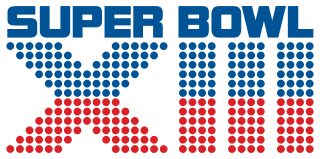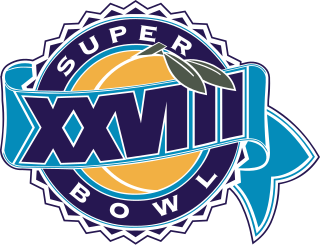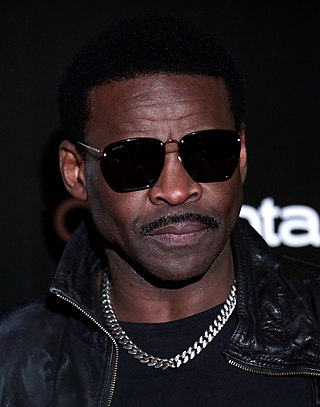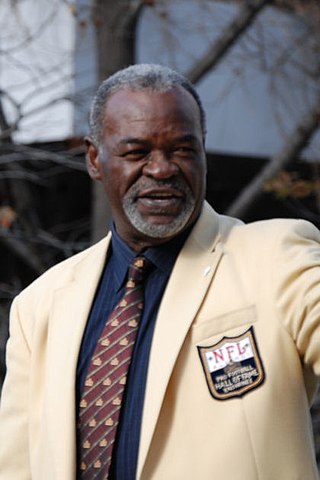Related Research Articles

Super Bowl XIII was an American football game between the American Football Conference (AFC) champion Pittsburgh Steelers and the National Football Conference (NFC) champion Dallas Cowboys to decide the National Football League (NFL) champion for the 1978 season. The Steelers defeated the Cowboys by the score of 35–31. The game was played on January 21, 1979, at the Miami Orange Bowl in Miami, Florida, the fifth and last time that the Super Bowl was played in that stadium.

Super Bowl XXVII was an American football game between the American Football Conference (AFC) champion Buffalo Bills and the National Football Conference (NFC) champion Dallas Cowboys to decide the National Football League (NFL) champion for the 1992 season. The Cowboys defeated the Bills by the score of 52–17, winning their third Super Bowl in team history, and their first one in 15 years. This game is tied with Super Bowl XXXVII as the fourth-highest scoring Super Bowl with 69 combined points, as of 2023. The Bills became the first team to lose three consecutive Super Bowls, and just the second of three teams to play in three straight. The following 1993 season, the Bills became the only team to both play and lose four consecutive Super Bowls. The game was played on January 31, 1993, at the Rose Bowl in Pasadena, California, and is the last NFL championship game to date to be held in a non-NFL stadium. It was also the seventh Super Bowl held in the Greater Los Angeles Area, which did not host another until Super Bowl LVI in 2022.

Super Bowl XXVIII was an American football game between the National Football Conference (NFC) champion Dallas Cowboys and the American Football Conference (AFC) champion Buffalo Bills to decide the National Football League (NFL) champion for the 1993 season. The Cowboys defeated the Bills, for the second straight year, by a score of 30–13, winning their fourth Super Bowl in team history, tying the Pittsburgh Steelers and the San Francisco 49ers for most Super Bowl wins. The Buffalo Bills became the only team to both play and lose four consecutive Super Bowls for a 0-4 franchise Super Bowl record, and as of 2023, remains the team's most recent Super Bowl appearance. The game was played on January 30, 1994, at the Georgia Dome in Atlanta. Since the 1993 regular season was conducted over 18 weeks, the traditional bye week between the conference championship games and the Super Bowl was not employed; the last time this had happened was before Super Bowl XXV.

Michael Jerome Irvin is an American sports commentator and former professional football player. He played his entire 12-year career as a wide receiver for the Dallas Cowboys of the National Football League (NFL). In 2007, he was inducted into the Pro Football Hall of Fame.
Larry Christopher Allen Jr. is an American former football guard who played in the National Football League (NFL) for fourteen seasons, primarily with the Dallas Cowboys. He played college football for the Butte Roadrunners and the Sonoma State Cossacks, and was selected by the Cowboys in the second round of the 1994 NFL draft. Allen is regarded as one of the NFL's physically strongest players ever, while also capable of using his speed against defenders.
Nathaniel Newton is an American former professional football player who was a guard in the National Football League (NFL) for the Dallas Cowboys and Carolina Panthers. He also was a member of the Tampa Bay Bandits of the United States Football League (USFL). He played college football for the Florida A&M Rattlers.
Erik George Williams is an American former professional football player who was an offensive tackle in the National Football League (NFL) for the Dallas Cowboys and Baltimore Ravens. He played college football at Central State University in Wilberforce, Ohio, where he was an NAIA All-American offensive lineman. Williams was a third-round selection in the 1991 NFL Draft.
The 1992 NFL season was the 73rd regular season of the National Football League (NFL). Due to the damage caused by Hurricane Andrew, the New England Patriots at Miami Dolphins game that was scheduled for September 6 at Joe Robbie Stadium was rescheduled to October 18. Both teams originally had that weekend off. This marked the first time since the 1966 NFL season and the AFL seasons of 1966 and 1967 that there were byes in week 1.
Mark Pulemau Tuinei was an American professional football player who was an offensive tackle for the Dallas Cowboys of the National Football League (NFL). He played college football for the Hawaii Rainbow Warriors. Known as a "gentle giant", his career lasted for 15 years (1983–1997) and his ability to protect quarterback Troy Aikman and to run-block for running back Emmitt Smith helped them win Super Bowls in 1992, 1993, and 1995 and the NFC East Division in 1985 and 1992-96. He was also selected for the Pro Bowl in 1994 and 1995.

Larry Rayfield Wright was an American professional football player who was an offensive tackle for the Dallas Cowboys of the National Football League (NFL) for 13 seasons. He is a member of the Pro Football Hall of Fame, having been inducted in 2006.
Hudson Houck is an American football coach and college player who was an offensive line coach for a six teams of the National Football League (NFL) over a 40-year coaching career. Houck retired on January 10, 2012.
Thomas Michael Rafferty is a former American football offensive lineman in the National Football League (NFL) for the Dallas Cowboys. He played college football for head coach Joe Paterno at Penn State University.
Raymond Canute Donaldson is an American former professional football player who was a center in the National Football League (NFL) for the Baltimore/Indianapolis Colts, Seattle Seahawks and Dallas Cowboys. He played college football for the Georgia Bulldogs.
Kevin Patrick Gogan is an American former professional football player who was a guard in the National Football League (NFL) for the Dallas Cowboys, Los Angeles/Oakland Raiders, San Francisco 49ers, Miami Dolphins, and San Diego Chargers. He played college football for the Washington Huskies and was selected in the eighth round by the Dallas Cowboys in the 1987 NFL Draft. With the Cowboys, Gogan won Super Bowl XXVII and Super Bowl XXVIII, both over the Buffalo Bills.
Patrick Emery Donovan is an American former professional football player who was an offensive tackle for the Dallas Cowboys of the National Football League (NFL). He played college football for the Stanford Cardinal. Sports Illustrated named him the fourth greatest Montana athlete of the 20th century.
John Christian Gesek Jr. is an American former professional football player who was an offensive lineman in the National Football League (NFL) for the Los Angeles Raiders, Dallas Cowboys, and Washington Redskins. He played college football for the Sacramento State Hornets and was selected in the 10th round of the 1987 NFL Draft. Gesek won two Super Bowls with the Cowboys over the Buffalo Bills as a starting offensive lineman.
The 1995 Dallas Cowboys season was the franchise's 36th season in the National Football League (NFL) and was the second year under head coach Barry Switzer and final of the three Super Bowl titles they would win during 1992 to 1995. Dallas would be the first team to ever win three Super Bowls in a span of four seasons. Switzer guided the Cowboys to a fifth Super Bowl win by defeating the Pittsburgh Steelers 27–17 in Super Bowl XXX.
Frank Edgar Cornish IV was an American football offensive lineman in the National Football League (NFL) for the San Diego Chargers, Dallas Cowboys, Minnesota Vikings, Jacksonville Jaguars, and Philadelphia Eagles. He was selected in the sixth round of the 1990 NFL Draft. He played college football at UCLA.
Herbert Anthony Adderley was an American football cornerback who played for the Green Bay Packers and the Dallas Cowboys of the National Football League (NFL). In 1980, he was enshrined in the Pro Football Hall of Fame.
Anthony Charles Wise is a former American football coach. He won one Super Bowl with the Dallas Cowboys of the National Football League (NFL) and one national championship at the University of Miami. He played college football at Ithaca College.
References
- ↑ "The Pennsylvania Football News All-Century Teams". pafootballnews.com. Archived from the original on February 18, 2006. Retrieved December 19, 2008.
- ↑ "Mark Stepnoski, Combine Results, OG - Pittsburgh". nflcombineresults.com. Retrieved November 16, 2022.
- ↑ "Mark Stepnoski RAS". ras.football. Retrieved November 16, 2022.
- ↑ "1989 NFL Draft Listing". Pro-Football-Reference.com. Retrieved May 26, 2023.
- ↑ "Countdown To Kickoff: Mark Stepnoski Takes "Center" Stage At #53" . Retrieved November 16, 2022.
- ↑ Eatman, Nick (July 3, 2012). "The 53: Stepnoski To Anchor The Middle". dallascowboys.com. Retrieved July 5, 2012.
- ↑ "Cowboys Offensive Line Shaping Up as Perhaps Greatest in NFL History" . Retrieved November 16, 2022.
- ↑ "Mark Stepnoski". Erie Sports Hall of Fame. Retrieved March 9, 2019.
- ↑ "Preliminary nominees for Class of 07". profootballhof.com. October 27, 2006. Retrieved March 9, 2019.
- 1 2 Donald, Mark (October 31, 2002). "Steppin' Out". Dallas Observer. Retrieved March 9, 2019.
- ↑ Armentano, Paul (April 10, 2003). "Lineman for Liberty". Reason. Retrieved August 9, 2021.
- 1 2 McKenna, Dave (November 21, 2003). "The Grass Is Sometimes Greener". Washington City Paper. Retrieved March 9, 2019.
- 1 2 Hruby, Patrick (January 21, 2003). "Fired up". The Washington Times. Archived from the original on August 9, 2021. Retrieved August 9, 2021.
- ↑ Outside the Lines: Marijuana in Sports, ESPN, February 23, 2003, retrieved August 9, 2021
- 1 2 Dudley, John (November 4, 2007). "Q&A; with Mark Stepnoski". Erie Times-News. Archived from the original on December 24, 2007.
- ↑ McFarland, John (February 21, 2003). "Former Cowboy Stepnoski now advocating marijuana legalization". Plainview Herald. Associated Press. Retrieved August 9, 2021.
- ↑ Townsend, Brad (September 22, 2016). "What the Dallas Cowboys think about marijuana". The Dallas Morning News. Retrieved August 9, 2021.